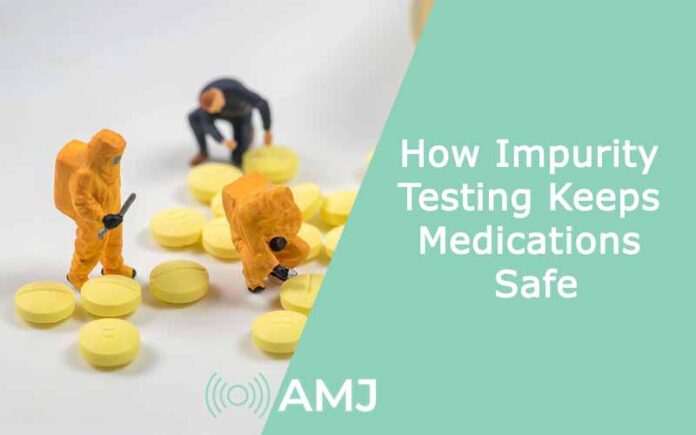When you pick up a prescription from the pharmacy, you trust that the medication is safe and effective. This assurance largely rests on rigorous safety protocols, among which impurity testing plays a crucial role.
Impurities in drugs can arise from various sources during manufacturing and can significantly impact the drug’s safety and effectiveness. By understanding how impurity testing works, we can appreciate the meticulous process that ensures our medications are not only effective but also safe for consumption.
Contents
Key concepts to understand the role of impurities in pharmaceutical manufacturing
- Definition of Impurities: Impurities are unwanted substances in drugs that can arise during manufacturing, affecting quality and safety.
- Sources of Impurities: Impurities can be introduced from raw materials, chemical reactions, or contamination during production.
- Impurity Testing Techniques: Techniques such as chromatography and mass spectrometry are used to detect and quantify impurities in drug products.
- Regulatory Standards: Guidelines set by authorities like the FDA and ICH that specify acceptable levels of impurities to ensure drug safety.
- Safety Assurance: The process of testing and validating that impurities are within safe limits to protect consumer health.
What are Impurities in Pharmaceuticals?
In pharmaceutical manufacturing, impurities are substances that are inadvertently introduced into a medication and are not intended to be part of the final product. These impurities can be organic compounds, inorganic elements, or residual solvents left from the production process. Their presence may affect the drug’s efficacy, safety, and stability, thus making it crucial to manage them effectively. The types of impurities commonly identified include:
- Organic impurities: Often derived from raw materials, byproducts of chemical reactions, or degradation products formed during the shelf life of the drug.
- Inorganic impurities: These might include catalysts or heavy metals which can be introduced during synthesis.
- Residual solvents: Chemicals used in the process of drug formulation that should ideally be removed but can sometimes persist in trace amounts.
Impurity Standards and Drug Safety
Impurity standards are crucial benchmarks that determine the acceptable levels of impurities in pharmaceutical products. These standards are not arbitrary but are scientifically established based on extensive research to ensure patient safety. Regulatory bodies such as the U.S. Food and Drug Administration (FDA) and the International Council for Harmonisation of Technical Requirements for Pharmaceuticals for Human Use (ICH) set these standards. They consider factors such as the toxicity of the impurity, its potential therapeutic benefits, and its likely exposure levels.
The implementation of these standards serves multiple purposes:
- Protecting Patient Health: By limiting impurities to safe levels, standards prevent adverse health effects.
- Ensuring Drug Efficacy: Impurities can interfere with the drug’s active ingredients, reducing effectiveness.
- Maintaining Consistent Drug Quality: Compliance with established impurity standards ensures that every batch of a drug is consistent with others in terms of quality and performance.
From the Lab to Your Medicine Cabinet
The journey of a drug from lab to pharmacy is a meticulous process governed by rigorous impurity testing to ensure patient safety. This pathway involves several critical steps:
1. Quality Control Testing
- Initial Screening: Each batch of the drug undergoes initial screening tests to identify any impurities present.
- Detailed Analysis: More detailed analyses follow, using the techniques described earlier (like HPLC, MS) to ensure that all impurities are identified and quantified.
- Adjustments and Optimization: If impurity levels are found to be above acceptable limits, adjustments to the manufacturing process may be made to optimize drug purity.
2. Regulatory Review and Approval
- Submission of Data: Comprehensive data on impurity levels and the methodologies used for testing are submitted to regulatory authorities.
- Review Process: This data undergoes a rigorous review process to verify that the drug meets all safety and efficacy standards set by the regulatory bodies.
- Approval: Once the review is satisfactorily completed, the drug receives approval for market release.
3. Manufacturing to Distribution
- Scale-Up: The drug manufacturing process is scaled up to produce large volumes, ensuring that the same standards for impurity control are maintained.
- Quality Assurance During Production: Continuous quality assurance checks are performed during production to maintain impurity standards.
- Packaging and Distribution: The final product is packaged in a controlled environment and distributed to pharmacies.
4. Pharmacy and Healthcare Providers
- Final Checks: Pharmacists conduct final checks to ensure drugs are not compromised before dispensing.
- Dispensing: Medications are dispensed along with appropriate guidance on usage, ensuring patients receive drugs that are safe and as effective as tested.
- Monitoring and Feedback: Healthcare providers monitor the effects of the medication on patients and provide feedback which may inform future manufacturing processes.
Each step in this process is designed to uphold the integrity of the medication, ensuring that what reaches the consumer is both effective and safe.
In conclusion
The rigorous application of impurity reference standards is crucial in ensuring the safety and efficacy of pharmaceuticals. By strictly regulating and monitoring impurity levels, the pharmaceutical industry can prevent adverse health effects and guarantee that medications perform as intended. Companies like Veeprho play an essential role in this process, offering specialized expertise in identifying, quantifying, and controlling impurities. Their work not only upholds strict regulatory standards but also fosters consumer trust in the pharmaceutical products that reach the market. Veeprho’s commitment to quality and safety exemplifies why such companies are vital to the overall health of consumers and the integrity of the pharmaceutical industry.












![Index of Money Heist [Season 1, 2, 3 & 4 – All Episodes, Cast and Plot] Index of Money Heist](https://www.asiamediajournal.com/wp-content/uploads/2021/05/Index-of-Money-Heist-3-100x70.jpg)